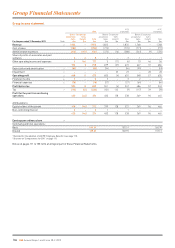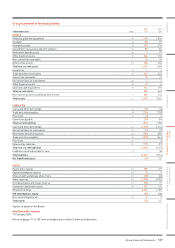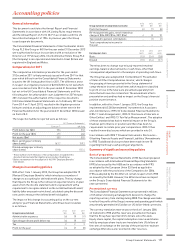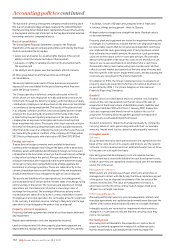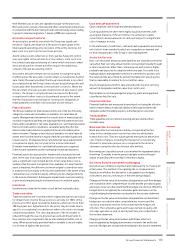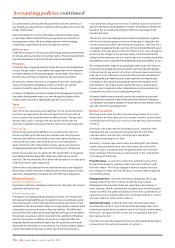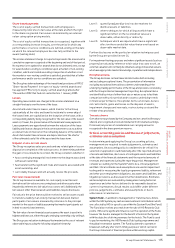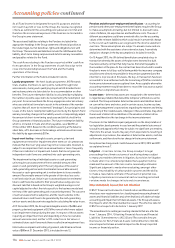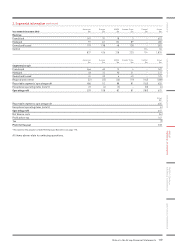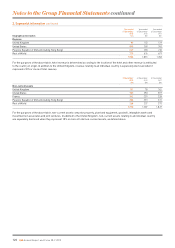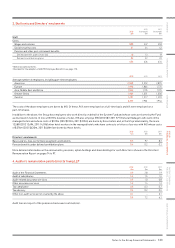Holiday Inn 2013 Annual Report Download - page 116
Download and view the complete annual report
Please find page 116 of the 2013 Holiday Inn annual report below. You can navigate through the pages in the report by either clicking on the pages listed below, or by using the keyword search tool below to find specific information within the annual report.
Documentation outlining the measurement and effectiveness of
any hedging arrangements is maintained throughout the life of the
hedge relationship.
Interest arising from currency derivatives and interest rate swaps
isrecorded in either financial income or expenses over the term of
the agreement, unless the accounting treatment for the hedging
relationship requires the interest to be taken to reserves.
Self insurance
Liabilities in respect of self insured risks include projected settlements
for known and incurred but not reported claims. Projected settlements
are estimated based on historical trends and actuarial data.
Provisions
Provisions are recognised when the Group has a present obligationas
a result of a past event, it is probable that a payment will be made and
a reliable estimate of the amount payable can bemade. If the effect of
the time value of money is material, theprovision is discounted.
An onerous contract provision is recognised when the unavoidable
costs of meeting the obligations under a contract exceed the
economic benefits expected to be received under it.
In respect of litigation, provision is made when management consider
it probable that payment may occur even though the defence of the
related claim may still be ongoing through the court process.
Taxes
Current tax
Current income tax assets and liabilities for the current and prior
periods are measured at the amount expected to be recovered
from or paid to the tax authorities including interest. The tax rates
and tax laws used to compute the amount are those that are
enacted or substantively enacted at the end of the reporting period.
Deferred tax
Deferred tax assets and liabilities are recognised in respect of
temporary differences between the tax base and carrying value
of assets and liabilities including accelerated capital allowances,
unrelieved tax losses, unremitted profits from subsidiaries,
gains rolled over into replacement assets, gains on previously
revalued properties and other short-term temporary differences.
Deferred tax assets are recognised to the extent that it is regarded
as probable that the deductible temporary differences can be
realised. The recoverability of all deferred tax assets is re-assessed
at the end of each reporting period.
Deferred tax is calculated at the tax rates that are expected to apply in
the periods in which the asset or liability will be settled, based on rates
enacted or substantively enacted at the end of the reporting period.
Retirement benefits
Defined contribution plans
Payments to defined contribution schemes are charged to the income
statement as they fall due.
Defined benefit plans
Plan assets, including qualifying insurance policies, are measured at
fair value and plan liabilities are measured on an actuarial basis, using
the projected unit credit method and discounting at an interest rate
equivalent to the current rate of return on a high-quality corporate bond
of equivalent currency and term to the plan liabilities. The difference
between the value of plan assets and liabilities at the period-end date is
the amount of surplus or deficit recorded in the statement of financial
position as an asset or liability. An asset is recognised when the
employer has an unconditional right to use the surplus at some point
during the life of the plan or on its wind-up. If a refund would be subject
to a tax other than income tax, as is the case in the UK, the asset is
recorded at the amount net of the tax. A liability is also recorded for
any such tax that would be payable in respect of funding commitments
based on the accounting assumption that the related payments
increase the asset.
The service cost of providing pension benefits to employees, together
with the net interest expense or income for the year, is charged to the
income statement within ‘administration expenses’. Net interest is
calculated by applying the discount rate to the net defined benefit asset
or liability, after any asset restriction. Past service costs and gains,
which are the change in the present value of the defined benefit
obligation for employee service in prior periods resulting from plan
amendments, are recognised immediately the plan amendment occurs.
Re-measurements comprise actuarial gains and losses, the return on
plan assets (excluding amounts included in net interest) and changes
in the amount of any asset restrictions. Actuarial gains and losses
may result from: differences between the actuarial assumptions
underlying the plan liabilities and actual experience during the year
or changes in the actuarial assumptions used in the valuation of the
plan liabilities. Re-measurement gains and losses, and taxation
thereon, are recognised in other comprehensive income and are not
reclassified to profit or loss in subsequent periods.
Actuarial valuations are normally carried out every three years and
are updated for material transactions and other material changes in
circumstances (including changes in market prices and interest rates)
up to the end of the reporting period.
Revenue recognition
Revenue arises from the sale of goods and provision of services
where these activities give rise to economic benefits received and
receivable by the Group on its own account and result in increases
in equity.
Revenue is derived from the following sources: franchise fees;
management fees; owned and leased properties and other
revenues which are ancillary to the Group’s operations,
including technology fee income.
Generally, revenue represents sales (excluding VAT and similar
taxes) of goods and services, net of discounts, provided in the
normal course of business and recognised when services have
been rendered. The following is a description of the composition
of revenues of the Group.
Franchise fees – received in connection with the license of the
Group’s brand names, usually under long-term contracts with
the hotel owner. The Group charges franchise royalty fees as a
percentage of rooms revenue. Revenue is earned and recognised
on a monthly basis.
Management fees – earned from hotels managed by the Group,
usually under long-term contracts with the hotel owner.
Management fees include a base fee, generally a percentage of
hotel revenue, which is earned and recognised on a monthly basis
and an incentive fee, generally based on the hotel’s profitability or
cash flows and recognised when the related performance criteria
are met under the terms of the contract.
Owned and leased – primarily derived from hotel operations,
including the rental of rooms and food and beverage sales from
owned and leased hotels operated under the Group’s brand names.
Revenue is recognised when rooms are occupied and food and
beverages are sold.
Franchise fees and management fees include liquidated damages
received from the early termination of contracts.
114 IHG Annual Report and Form 20-F 2013
Accounting policies continued


